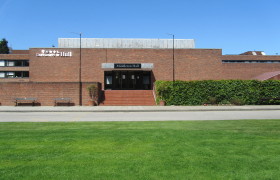This website uses cookies
This website uses cookies to enable it to function properly and to analyse how the website is used. Please click 'Close' to accept and continue using the website.



Photo © C20 Society

Sir Leslie Martin’s Middleton Hall, an important post-war listed building at the University of Hull, is a recent case revealing critical gaps in our historic protection system. It is set for a raft of damaging alterations and extensions, but if listing had been dealt with earlier, we could have had a very different outcome.
Middleton Hall (1965–67) comprises a concert hall and chapel. Its special interest is summed up by English Heritage’s listing description: ‘Middleton Hall expresses the themes of Martin’s best work of the later 1950s and the 1960s in its low-key, careful brick massing, and strongly emotive spaces, clearly referencing the work of Finnish architect Alvar Aalto.’ Inside, the building is ‘handsomely appointed with polished beech panelling to the hall and foyer, and wood block floors to the broad, outer corridors, while the cube form of the small, non-denominational chapel is particularly powerful, successfully displaying the three-dimensional geometry apparent in Aalto’s designs.’
Sir Leslie Martin (1908–2000) headed the team that designed the Grade I Royal Festival Hall. He was influential in the higher education sector, both as the first Professor of Architecture at the University of Cambridge, and through his private practice. He was responsible for the Hull campus master-plan, but this is one of the only two of its buildings that he designed himself.
We first put Middleton Hall forward for listing to EH in 2005, and while the application was registered, it was not progressed any further. In 2013, we heard about proposals which included a large exterior plant enclosure at ground floor level, major extensions to the front facade (including a new café and entrance lobby), re-modelling of the auditorium and irreversible changes to the plan form of the building. We objected to the scheme and asked EH to expedite the listing application as a matter of urgency. Unfortunately, EH did not comment on the proposals, because the building was not then listed.
We were delighted when Middleton Hall was listed at Grade II in April 2014, which meant that, as well as planning permission, listed building consent (LBC) would be needed to implement the scheme that so concerned us. The criteria for assessing LBC applications are of course much more specific than planning considerations. But, disappointingly, the revised scheme submitted for LBC was similar to the 2013 permission. Despite the new listed status of the building, the University did not make significant modifications or seek professional heritage advice, and there was no Conservation Management Plan to help identify what was significant about the building – common practice now when dealing with alterations to listed buildings, and useful to help minimise damage. We objected very strongly to the plans, and were disappointed that EH sought only minor amendments before supporting them, rather than insisting on the fresh approach needed. Despite our best efforts, the plans were passed by Hull City Council’s planning committee in July 2014.
We realise that working buildings like these need to accommodate changes, but those proposed here will irrevocably compromise Middleton Hall. It would be inconceivable to treat a listed building of an earlier century in this way, and we feel that the University is jeopardising the value of its own heritage. Had the building been listed back in 2005 when we first put it forward, we are sure that there would have been a better outcome. The University would have drawn up its plans knowing their building was listed, and we would have been consulted on them at an earlier stage, leaving room for major concerns to be worked through.
Harvey Court, a university building in Cambridge – also by Leslie Martin – is a good example of how early consultation can make a real difference. In 2009 we were consulted on plans to alter and extend the Grade II* halls of residence (1960–62). Along with EH and the local planning authority, we raised concerns at pre-application stage which were subsequently addressed or robustly justified by the College. We ended up with a much less drastic scheme, and were delighted to be able to support the plans at the end of the process.
These cases demonstrate the need for a substantial listing programme rather than one mainly dependent on threat as a trigger. In the meantime, there are two more very important C20 buildings on Hull’s campus: Martin’s Larkin arts building, linked to Middleton Hall, and the Gulbenkian Centre for drama by Peter Moro and Partners (1969). We will be highlighting their importance with both English Heritage and the University shortly.
Henrietta Billings
See also:
Heritage Fudge – further compromises to Leslie Martin’s Hull masterpiece
Heritage breakdown – delays in listing system threaten Leslie Martin masterpiece

Become a C20 member today and help save our modern design heritage.